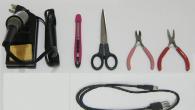Most often, the public condemns adults falling into childhood. But, you see, sometimes it is so pleasant, forgetting about everyday problems and troubles, with rapture to plunge into the wonderful world of children's games and entertainment.
The other day I was fortunate enough to briefly return to a carefree childhood. And it happened quite by accident.
Late in the evening, wandering around Pinterest looking for interesting ideas for New Year's crafts, I came across photographs of works made from thermomosaic.
Ikeev's set, presented to my daughter for her birthday, consisting of plastic beads, thermal paper and special plastic bases with pins for laying out thermal mosaics, had been lying idle at our house for several months.

And suddenly I realized that I absolutely needed to test the thermal mosaic in action, and immediately make something from it. I had to spy into the room to the sleeping children and get a jar with the coveted beads from the shelf.

Thermal mosaics are laid out according to the same principle as ordinary mosaics. The only difference is that the beads are not inserted into the holes of the base, but strung on special pins of a plastic form.

In addition, thermal mosaic beads can be fused together by ironing the laid out picture with an iron through thermal paper, and as a result, you can get a solid figure for games or interior decoration.
So, everything is ready for work. It remains to decide on the image to be laid out from the thermomosaic.
Like most adults, it did not even occur to me to turn on my sleeping fantasy due to the late time, and I decided to look for ready-made schemes for thermomosaics. There were more than enough of them on the Internet.
That is why my choice may surprise you. Why? Yes, because I decided
do it yourself Minion - the character of the cartoon "Despicable Me"

The fact is that my children are delighted with the contemplation of this creature on the computer screen, and after watching the cartoon they play "minions" for a long time.
These three schemes inspired me to create my own minion from thermomosaic:


1. Having made some minor adjustments to the sample scheme, I laid out my minion from thermomosaic beads on a special plastic mold.

2. Having covered the laid out image with thermal paper, included in the set of thermomosaic, I ironed it with a strongly heated iron for 3 minutes.

The top edge of the plastic beads melted and the beads joined together.
3. Then I carefully removed the paper and put the figurine of the thermomosaic minion on a flat hard surface so that the melted side of the figurine was at the bottom, and the edges of the beads that were not processed with an iron were on top.

She again covered the figurine with thermal paper and ironed it with an iron.
Many lovers of thermo mosaic crafts work with an iron only on one side of the figurine. However, beads that are melted on both sides hold on more tightly and the figurine is stronger and more durable.
4. Letting the minion figure cool down a little, took off the thermal paper and placed the finished figure under the press for several hours so that the thermomosaic craft would not lose its shape during the solidification process.
Let me tell you a little secret: in fact, the little minion is not alone. He has a twin brother (well, or almost a twin) - the first, in my opinion, not a very successful experimental copy. As the saying goes, find ten differences:

In general, the process of creating crafts from thermomosaics turned out to be fascinating, and, perhaps, you will still see our new products in this technique on the blog for creative mothers and grandmothers.
And now the answers to some questions that you may have during the manufacture of crafts from thermomosaic:
What can replace the special thermal mosaic paper?
With such a huge jar of beads as mine, 2 sheets of thermal paper is unforgivably small. Especially if the skill of working with thermal mosaics is not yet available.
Thermal paper can be replaced with tracing paper. But it is best to iron the thermo mosaic beads through baking parchment. Tested: It does not stick to the molten figurine and is easy to remove.
To what temperature does the iron need to be heated to make crafts from thermomosaic?
Personally, I prefer to preheat the iron to the maximum in the "cotton" or "three" mode. This will melt the beads faster.
Do not overdo it when melting the plastic beads of the thermal mosaic with a hot iron! Otherwise, you will get a thin melted pancake (see above: Minion # 1 - experimental).
How many minutes to fix the thermo mosaic beads with an iron?
The image, laid out of plastic beads, is melted with an iron heated to the maximum temperature for 2-3 minutes on each side (or on one side, if desired). It all depends on the iron and on the quality of the figurine you want to get.
For example, I like figures without holes more, so I iron the image from the thermomosaic with an iron longer.
Where can I get schemes for a thermomosaic?
Look for schemes for thermomosaics on the websites of manufacturers. There, the pictures on the ready-made sets are presented in good resolution, and when you zoom in, you can easily see the diagrams of the figures.
You can use simple cross stitch patterns as patterns for laying out thermal mosaics.
Where to buy a thermomosaic?
Sets of thermomosaics, beads and base molds for it can be purchased in stores of goods for creativity, in the departments of children's toys or stationery, or you can order a thermomosaic in the online store.
Forget about household chores - remember how great it is to be a child with HobbyMama!
Thermo mosaic is an excellent material for creativity with children over 3 years old. It is a set of colored plastic beads of a cylindrical shape, which are laid out in the form of a pattern on a special base with pins, and then ironed with an iron through thermal paper (parchment). When heated, the top layer melts and the beads are connected to each other, forming a solid figure. Thus, together with the child, you can create various crafts from thermomosaic: jewelry and accessories, home decor, toys and gifts for the holidays.
Instructions for working with thermomosaic
You will need:
- beads for thermomosaic (v, v, na);
- basis for thermomosaics (c, c, na);
- a set of molds for thermomosaics (c, c, n);
- thermal paper (in, in, on) or replace with baking paper;
- tweezers (on);
- iron;
or use a ready-made set for a thermomosaic (v, v na).
Thermo mosaic is suitable for children 4-5 years old, but there are also sets for children from the age of three - they differ in the size of beads, in sets for the smallest they usually have a diameter of 10 mm.
Standard sets for children from 5 years old are completed with beads with a diameter of 5 mm, and for older children - very small, 2.5 mm in size.
Different sets of thermal mosaics are completed with different plates with pins. They can be in the shape of a butterfly, horse, bunny, etc. There are also universal bases - square, round, oval. The former are easier to use, the latter are more practical and give more room for creativity. It is best to have both, start with blanks and move on to free creativity. If the child is old enough, then you can do only with universal tablets.
How to do
1. Have the child lay out the pattern on the form by placing the beads on the pins (use tweezers for convenience). You can assemble the mosaic according to the schemes, or you can do it on your own, relying on your imagination. It is very convenient for kids to use a transparent tablet, under which you can put a template and collect on it.
2. Heat the iron to medium heat.
3. Then place thermal paper on the finished image and carefully iron the mosaic surface in a circular motion with a hot iron. (this stage is only allowed to be done by adults or children under the supervision of parents). In time it will take about 10 seconds.
4. Remove the resulting figure from the tablet, turn it upside down, untouched side. Place on a flat wooden surface. Cover with paper and iron for another 10 seconds.
5. In order for the figure not to deform after cooling and to remain level, it is necessary to put a weight on top for a few minutes.
What does thermomosaic develop?
Classes with thermomosaic provide many opportunities for the formation of a child's personality. In addition to the development of fine motor skills of hands, it gives the opportunity to play with color, which helps the development of artistic abilities, imagination and creativity. The ability to lay out drawings according to schemes - develops the ability of visual-motor coordination of movements, which is important for preparing children for writing. Counting the number of necessary parts and rows in the drawing will definitely help in the development of the child's mathematical abilities, his intellect. When laying out figures from a thermomosaic, in addition to developing abilities, children develop such character traits as patience and concentration, accuracy and attention.
What to make from a thermomosaic: ideas for crafts, diagrams
Bookmarks
Create colorful bookmarks for books using thermal mosaics and large paper clips with your child. Lay out the thermal mosaic according to the scheme (download), iron it through thermal paper, glue the finished figures with hot glue to paper clips.
Source: perler.com
Bookmarks "Fruits" from thermal mosaics and wooden sticks for ice cream (diagram).

Source: perler.com
Accessories and jewelry for children
Thermomosaic bracelets
Option 1. Place the thermobeads on the base in any color combination. It is important that the ends of the future bracelet are made at different angles for correct alignment. Iron through thermal paper. Take the strip while still warm and wrap it around the glass, closing the bracelet. Iron the bracelet again to secure the ends.

Source: diycandy.com
Option 2. Even a 4-year-old child can make a simple bracelet from thermo beads. Pre-flatten the beads with an iron, wait until they cool down and invite the baby to string them on an elastic thread.

Source: craftandcreativity.com
Option 3. Weave a bracelet from thermo beads in the same way as beaded jewelry is weaved according to patterns.

Source: diycandy.com
Thermomosaic headbands for girls

Source: perler.com
For making, you will need: a simple bezel (on), a thermal mosaic (diagram) and a thermal gun for gluing jewelry to the bezel. Source: perler.com

Source: eighteen25.com
Summer earrings from mini thermo beads

Source: perler.com
Thermomosaic necklace

Source: thecraftedsparrow.com

Invite your child to draw their own design for the future necklace.

Source: blog.modcloth.com
Buttons for children's clothing
You can make bright buttons for a children's outfit from a thermomosaic.

Source: makermama.com
Molten Thermal Mosaic Hairpins
Line a baking sheet with baking paper, lay out the pattern from thermo beads and put in preheated to 200 gr. oven for about 10 minutes. When the beads are melted, remove the baking sheet from the oven and let cool. Hot glue the finished figurine to the hairpin. A bright hair accessory is ready!

Source: the36thavenue.com
Carnival masks
Thermomosaic mask for a girl (diagram).

Keychains for keys "Fruits"

Source: mypoppet.com.au

Phone case decor

Gift decoration
The creation of festive packaging is a very exciting process that will appeal to both adults and children. With themed figurines from thermomosaic, you can make original gift wrapping for any occasion.

Source: meinfeenstaub.com
Festive packaging for the New Year

Thermomosaic postcards
Valentine's Day card (outline).

Source: perler.com

Home decor from thermomosaic
Pencil holder

Garland

Thermal mosaics are small beads made of thermoplastic plastic that can be laid out in interesting patterns on a special form. After heating the prepared pattern, the beads are soldered together into one whole craft! Thermal mosaic is relatively inexpensive, and you can make patterns and figures of any shape from it. After purchasing a thermo mosaic from your local craft store or online store, you will very soon begin to successfully create your creations.
Steps
Part 1
Creating a thermal mosaic pattern- flatbed base for thermomosaic;
- iron;
- parchment paper (or tracing paper);
- thermomosaic.
-
Choose a suitable flatbed or thermomosaic mold. There are quite a few thermosaic molds that you can use for your crafts. For example, you can make a figurine of a dog, a fish, a shoe, make a hexagon, and so on. Thermomosaic manufacturers produce a wide variety of ready-made shapes, but you also always have the opportunity to use a regular thermal mosaic tablet base and lay out your own pattern on it.
Prepare beads of matching colors. It is sometimes difficult to pull out small beads of a thermomosaic from their containers. In order not to fight with the beads during work, each time trying to get the right one, it will be more convenient for you to arrange the beads by color in separate bowls or baking dishes.
Assemble the pattern from the thermal mosaic in accordance with the diagram. If you are working with a ready-made mold for a thermomosaic, for example, in the form of a cat, you can put the beads on the pins of the mold as you like. If you use a transparent tablet base, then before starting work, you can put a sheet with a diagram under it, or you can simply come up with and create your own design.
Part 2
Securing the created pattern-
Heat the beads on one side. Take parchment paper (or tracing paper) and cover the assembled beads with it. Be careful not to accidentally knock the beads out of place. Heat the iron to medium heat and then slowly iron the paper in a circular motion. It will take you about 10 seconds to solder the beads together.
Heat the back of the beads. After the beads and the base itself have cooled down a little, they can be turned over to the other side. As a result, the craft will be removed from the pins and expose the cold side of the beads.
Separate the paper from the craft and let it cool. Grasp the corner of the paper and carefully remove it from the beads. The beads will be hot enough when you finish ironing them, so allow them to cool for a few minutes before touching your thermo mosaic creation.
- Now your work is completely ready for demonstration! Take it off the base and show your friends what you've got.
Part 3
Additional creative techniques-
Make your thermo mosaic art shine. This technique will give your crafts a magical touch and will be useful when making figurines of ponies, unicorns or fairies. Just take some small sequins and sprinkle them on the beads you have collected before ironing them. When you solder the beads together, the finished craft will already shine!
Create thermo mosaic decorations. Line a baking tray with parchment paper and place metal dough tins on it that are safe to use in the oven. Then fill in the molds with thermosaic beads. In this case, you can use beads of the same color or different colors. Just do not pour the beads into the molds all the way to the top, otherwise the plastic may spill over the edge of the mold during baking.
Make a thermal mosaic cube. This craft is best done on a medium-sized square tablet base. Lay out two separate rows of three beads on the base. Then lay out three H-shaped figures with three bead-high sides. The center bar of each letter should be one bead. All parts must be separated from each other by at least one row of empty base pins.
- Store unused thermo mosaic beads out of the reach of small children. They can pose a risk of suffocation if the child chokes on them.
-
Prepare everything you need to work with the thermal mosaic. You will need a flat, stable surface to prepare your pattern. The special flatbed base for thermo mosaic has short enough pins for placing the beads, therefore, due to the uneven working surface, the beads can jump off the pins. In general, to work with a thermomosaic, you will need:
When we did, we took out the thermomosaic once again. Well, and of course, they began to actively play with her after the weekend.
Therefore, I decided to show and tell why I love thermomosaic
So, let's start with what a thermal mosaic is in general, in case you haven’t met such a toy yet.
You have a tablet - a base with pins. These same tablets are very different. The simplest is a square. If this is a Hama thermal mosaic, then the square will have grooves for connecting with others of the same. This is needed to create large images.
If you bought a Ses, Lori, Ikea tablet, then your square will not connect to anything even in distant plans
As you can see in the picture, there are other options as well. A circle is a very useful shape, only a little more would be better. The heart is almost a square, only it has small specific roundings. Not only hearts can be made on this tablet!
And a very cool hexagonal tablet. You can make a lot of great pictures on it.
I specifically bought such a set for the sake of a tablet. Although, of course, they are sold separately, you just need to find where exactly. Now I already know where :)
There are also such attractive at first glance tablets - ready-made figures. But, experience has shown that they are just the least used. Because nothing else but a given figure cannot be assembled on them.
The beads themselves are also different. The size is basically the same for all manufacturers - 5 mm in length. And there are also super-small beads of 3 mm and 2.6 mm! Their trick is that the resulting figure will be flexible. But this, of course, is no longer for children.
It seems that Hama has large beads for babies. I have not seen such, but I think that if there are such, then it's cool.
The only thing to remember is that each size needs its own tablets !!!
But, oddly enough, something depends on the manufacturer.
If you plan to make ordinary flat pictures, key chains, earrings, etc. - then any will do. There will be only a question of color. There are a lot of flowers in a cheap ikeevsky jar, but there will be no more shades
The ready-made sets will contain beads of matching colors, but they are enough for 1-2 figures. And if you yourself want to buy a specific color - then this is again Hama - I saw up to 60 colors, but I think there may be more.
When else you might need Hama - if you decide to make a voluminous project. Unfortunately, ikeia beads, etc. if they are weakly melted, it is bad to hold, and if it is strong, then they do not join. And a miracle can no longer be created such a plan. 

But let's get back to the mosaic itself. What exactly is so unusual about it that distinguishes it from other mosaics
And the thing is that first we collect a picture from colored beads. And then we iron it through special paper (baking paper works great). And in our hands we have a flat colored thing :)
Do you see these flowers? They are from thermomosaic. They were made by a caring brother for his little sister for the new year.
Why is it interesting and useful?
Let's start with the fact that it is bright, simple pictures are collected quickly enough, and a 3-year-old child, after a little effort, can get a bright and cute result - a flat figure for play or just beauty.
What is useful in this?
- Well, of course, fine motor skills. Taking 5mm beads with your fingers and placing them on a small pin is a great job.
You can also learn tweezers! In fact, tweezers can be tough without tweezers in large and complex jobs. And it is very useful for kids to master this tool.
And if the beads are all in one jar - a bowl, then they also need to be sorted, to find the right one. You can, of course, look for the right bead every time you work. But this, as you can imagine, is not very rational. It's a constant distraction. This means that we will select the required beads in advance. Thus, on the one hand, we teach the child the correct, rational organization of his activities. On the other hand, we train attention - looking for the right color among many is another task, especially for a baby.
When you collect a beautiful picture that you like, you can have a little patience, try ... In general, we gradually develop concentration, a volitional sphere.
For example, Alenka couldn't put together this picture at once - it's too big. We divided it into 2 approaches. Moreover, I was honestly going to collect it in 3 times. But when the finale was already visible, the child gathered herself up, and with a strong-willed effort finished the work.
Work according to the scheme.
Read the diagram, count the parts, navigate on your tablet, put, check. O! This is a very difficult job not only for a toddler, but also for older children. This is a skill, a very important skill that we can develop just by playing with mosaics.
You can work with the diagram even deeper.
There are a lot of photographs of works and pictures in the network. We take a high-quality picture, make it large on the monitor and ask the child to draw a diagram in a notebook. A very good assignment at both 5 and 7 years old. If a rectangular tablet is mastered quickly enough, then circles, hexagons ... there are more questions.
Here in the photo you can see a box with pencils. First, Alice drew herself a diagram, now she collects
By the way, here's an interesting observation along the way. Alice first copied the schemes with color - painted over the necessary squares. And only over time, she saw that it was more rational not to paint over, but to put just a colored icon, or even non-colored. And more recently, she herself realized that you can simply designate the desired color with a letter or number. And this little discovery of hers is worth a lot
You can fantasize and collect your pictures, patterns. And then sketch them as a keepsake
- By the way, yes, with the help of a thermomosaic, you can perfectly work out what is on a regular mosaic: symmetry, sequence, similarity.
But such pictures are an excellent material for various gifts, decorations, festive decor, they can become elements of a postcard or directly play material 

Well, or simpler 
We have such a varied food that has been living in toys for 7 years. Slava once did it for Alice, and we are slowly updating it as needed.
But these cars Slava made as a gift to children in kindergarten. Just? Oh sure. But for a person 4.5 years old is just that. And how happy the boys were. And how happy the speech therapist and the teacher was! After all, they arranged a competition. Blow on cars to make them move to the finish line! Great workout :)
But you can make such beauties too 
And, most importantly, such a project is within the power of a 4-5 year old child! You see, probably no other material gives such freedom. Doesn't give such simplicity in achieving the result. Minimal help from parents, and the child gets a truly beautiful, bright contraption that gives him joy, with which to play, which can be used.
This photo immediately shows which book Alyonka has recently read. Well, of course, about Elmer the elephant. But she didn’t make an elephant, but a dog.
Well, we also use mosaics as beads, of course.
- this is just food that we pour - we pour in games
- cargo that can be filled into the body of a dump truck and brought in the game
- this is a necklace for a doll
- this is also the replacement of large beads in weaving simple crafts. Something with which it is easy enough to start weaving for a baby
Well, kinesthetics are pleased to simply run their hands into a bowl of beads and sprinkle them from palm to palm.
I myself am at my leisure, when he suddenly appears, or next to the children, I am happy to collect pictures. I like both the process and the result.
In general, I think it is already clear that I love thermomosaic, and so do my children :)
Do you have a thermal mosaic at home? Show what you make of it? Children like? And you yourself?
We have BOOM! Thermomosaic is my new hobby! In fact, mothers very often choose those activities, toys, and developmental activities for the baby that personally cling to mothers.
Pros - fine motor skills in their purest form, these are beads !!! Girls will be delighted, and boys…. when you see what kind of DINOSAUR we made today and a couple of ideas we put in a piggy bank ... the boys will not resist! And for boys, due to the peculiarities of the development of the brain and the possible lag behind girls of the same age in terms of fine motor skills, which will be very noticeable in the elementary grades, this is just a must do.
So let's get started. There are a lot of sets in stores, we bought the most effective in terms of price-quantity ratio. A set about a kolobok (fu!) With a huge number of beads (super!) And a large square tablet (super!). The tablet is the most important thing, because only on a large tablet you can a child collect whatever he wants, and on a small tablet in the form of a dog - only a dog.
Our beads !!!

At first they collected the house, quickly got tired of it, did not begin to finish it.

Putting the house together ... we didn't even finish it, they left it
We decided to do something small for the first time, simple and interesting. DINOSAUR!
The work for the kid is very difficult due to two points - directly placing the small beads on the tablet, although the pegs help and prevent the beads from moving, but for small clumsy fingers this is a real training in accuracy (and stamina). Secondly, it will be difficult for the younger ones to orient themselves according to the scheme and to count the beads. So for now we will work together! A wonderful joint activity!
So we began to lay out the dinosaur, I am the navigator, I am leading us according to the scheme, the younger one is putting the beads on the tablet. Then they ironed (I ironed) the dinosaur with an iron at maximum through tracing paper. This is how it looks, you can clearly see how the beads began to melt. Do not forget to remove the figurine from the tablet, it will remain on the tracing paper.
Unfasten the tracing paper and place it under the weight for 10 minutes. We put wooden cubes under the set. And here is our dinosaur !!! Nice! We immediately created a habitat for him, people came running to take pictures and in general.
The whole process took us 20 minutes plus 10 minutes under weight. An excellent project to start with, when you are not yet sure how the iron will behave and in general you want to make and play as soon as possible ...


The dinosaur under the tracing paper is still on the tablet. I forgot to take it off, but I remembered it in time.



If you have small transparent jars of hotel shampoo or baby food, there are no better storage containers.



Schemes for a thermomosaic in a piggy bank.

Thermomosaic schemes

Thermomosaic schemes







